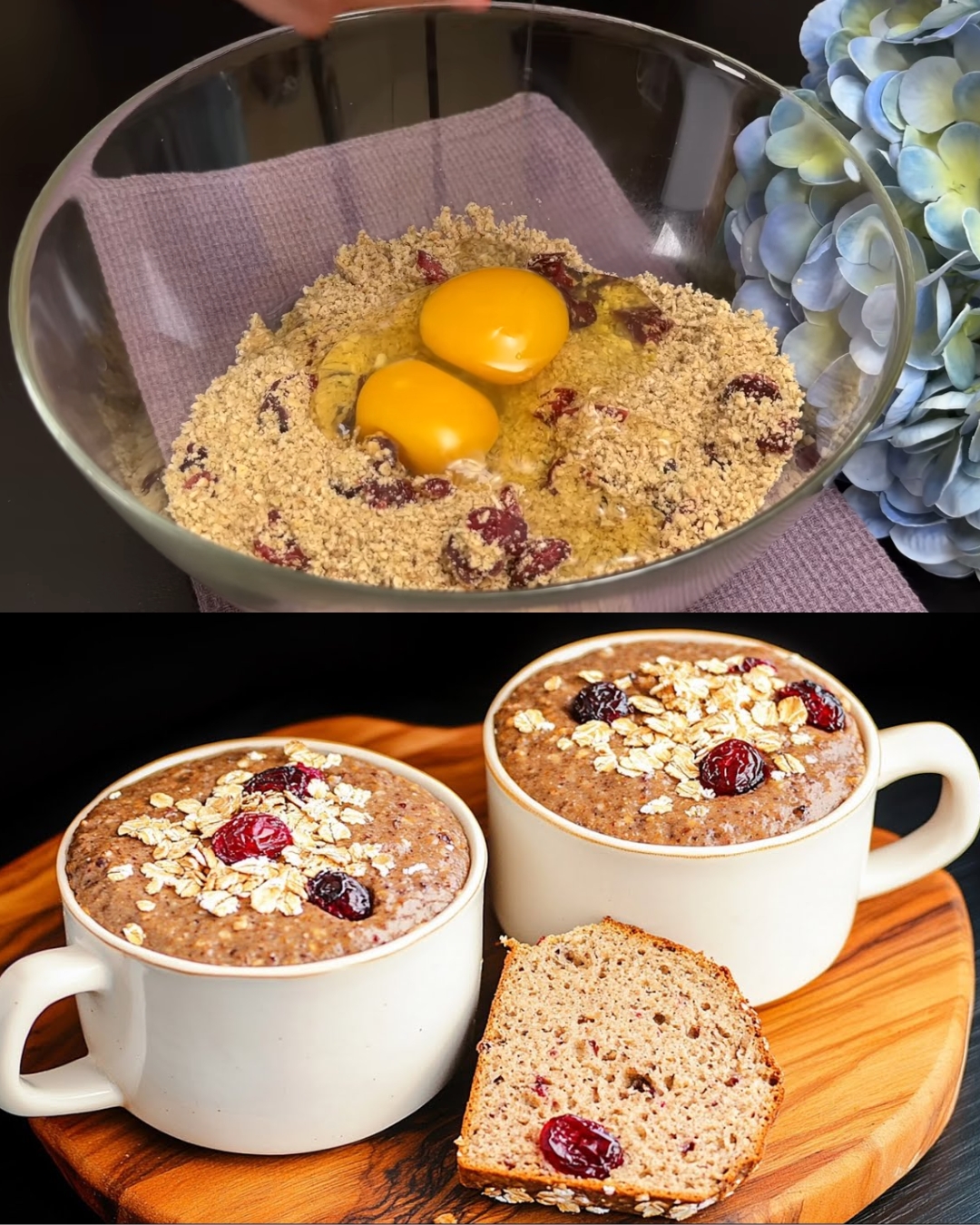This Seeded Oat and Nut Bread is a powerhouse of nutrition, flavor, and texture—made entirely without traditional flour or yeast. Bound together with eggs, water, and psyllium husk, and packed with crunchy walnuts, chewy dried cranberries, and hearty pumpkin seeds, this bread is not only gluten-free but also naturally high in fiber and protein. Topped with fresh avocado and tomato and finished with a drizzle of olive oil and fragrant spices, it makes for a wholesome meal or snack any time of the day.
Let’s dive into the full breakdown of this beautiful bread: from how to make it to why it’s a brilliant addition to your healthy recipe collection.
Cooking Time
-
Prep Time: 20 minutes
-
Resting Time: 1 hour
-
Bake Time: 60 minutes
-
Total Time: About 2 hours 20 minutes
-
Yield: 1 loaf (8–10 slices)
Ingredients
-
100 g walnuts
-
60 g pumpkin seeds
-
150 g oatmeal (whole or quick oats)
-
60 g dried cranberries
-
2 eggs
-
240 ml water
-
Salt, to taste
-
50 g psyllium husk
-
1 fresh avocado
-
1 fresh tomato
-
Olive oil (for topping and brushing)
-
Sesame seeds, for sprinkling
-
Garlic powder, sweet paprika, ground black pepper (for seasoning)
Step-by-Step Cooking Directions
1. Prepare the dry mix
In a large bowl, combine 100 g chopped walnuts, 60 g pumpkin seeds, 150 g oats, and 60 g dried cranberries. Stir well to evenly distribute all the dry ingredients.
2. Add eggs and water
Crack 2 eggs into the bowl, pour in 240 ml of water, and mix to combine. Add a pinch of salt for balance.
3. Add psyllium husk
Incorporate 50 g of psyllium husk into the mixture. This is your binding agent, essential for forming a dough-like texture without flour. Mix thoroughly until the dough becomes thick and sticky.
4. Let it rest
Cover the bowl with plastic wrap and let the dough sit at room temperature for 1 hour. This allows the psyllium to absorb moisture and create structure.
5. Shape and prepare for baking
Once rested, shape the dough into a loaf or press it into a parchment-lined loaf pan. Brush the top with olive oil and sprinkle with sesame seeds for texture and flavor.
6. Bake the bread
Bake in a preheated oven at 200°C (392°F) for about 60 minutes, or until firm and golden brown on top.
7. Cool and slice
Let the bread cool completely before slicing—it will continue to firm up as it cools.
8. Prepare the topping
Slice the fresh avocado and tomato. Layer on top of each slice of bread. Drizzle with olive oil and sprinkle with garlic powder, sweet paprika, and black pepper to taste.
Nutritional Information (per slice, approx.)
-
Calories: 260
-
Protein: 8 g
-
Fat: 18 g
-
Carbohydrates: 17 g
-
Fiber: 7 g
-
Sugar: 4 g
-
Cholesterol: 40 mg
-
Sodium: 60 mg
The Origins and Popularity of the Recipe
This kind of bread is inspired by Nordic seed breads and modern low-carb baking trends, where grains are replaced with a medley of seeds, nuts, and natural binding agents. The popularity of psyllium-based breads and flourless loaves has exploded in health-conscious circles and among those following gluten-free, paleo, or low-FODMAP diets.
The inclusion of toppings like avocado and tomato mirrors the Mediterranean diet, known for its heart-healthy benefits and emphasis on fresh, whole foods.
Reasons Why You’ll Love This Recipe
-
Gluten-free and flourless
-
Fiber-rich and heart-healthy
-
Hearty enough for breakfast or lunch
-
Great for meal prep—stays fresh for days
-
Customizable with endless topping ideas
-
Works as toast, open-face sandwich, or snack
Health Benefits
This recipe is packed with nutrition from natural ingredients:
-
Oats support heart health and digestion
-
Psyllium husk is excellent for gut health and reducing cholesterol
-
Walnuts and seeds provide omega-3 fatty acids
-
Cranberries add antioxidants and subtle sweetness
-
Eggs offer protein and essential vitamins
-
Avocado contributes healthy fats and fiber
-
Tomatoes bring lycopene, a powerful antioxidant
Serving Suggestions
-
Serve sliced with the avocado-tomato topping
-
Add a soft-boiled egg or poached egg on top
-
Spread with hummus or Greek yogurt
-
Serve with soup or salad for a light lunch
-
Toast and serve with nut butter and sliced bananas for breakfast
Common Mistakes to Avoid
-
Skipping the resting time – Psyllium needs time to absorb the liquid and form structure
-
Not mixing thoroughly – Uneven distribution leads to crumbly bread
-
Cutting before cooling – This bread needs time to set completely
-
Overbaking – Can lead to a dry, overly dense loaf
-
Underbaking – Causes sogginess inside; test with a skewer for doneness
Pairing Recommendations
-
Beverage Pairing: Pairs well with green tea, cold brew coffee, or lemon-infused water
-
Soup Pairing: Excellent with tomato soup, lentil stew, or mushroom broth
-
Cheese Pairing: Try with feta, goat cheese, or vegan cashew cheese
-
Fruit Pairing: Serve with sliced figs, grapes, or pomegranate seeds for a sweet touch
Cooking Tips
-
Use quick oats for a smoother texture or steel-cut oats for a chewier result
-
Toast the nuts and seeds beforehand for deeper flavor
-
Store in an airtight container in the fridge for up to 5 days
-
Freeze slices individually for grab-and-go breakfasts
-
Add herbs or spices like rosemary or cumin for a savory version
Similar Recipes to Try
-
Flourless Seed Crackers
-
Keto Almond Bread
-
Sweet Potato Oat Bread
-
Chia and Sunflower Seed Loaf
-
Zucchini Walnut Breakfast Bake
Variations to Try
-
Savory Version: Add olives, sun-dried tomatoes, and rosemary
-
Sweet Version: Swap cranberries for raisins, add cinnamon and honey
-
Spicy Kick: Add chili flakes or jalapeños to the batter
-
Protein Boost: Add chia seeds or a scoop of protein powder
-
Low-Egg Version: Use flax eggs (1 tbsp flaxseed + 3 tbsp water per egg)
Ingredient Spotlight: Psyllium Husk
Psyllium husk is a natural fiber supplement derived from the seeds of Plantago ovata. It acts as a binding agent in this recipe, replacing flour and gluten’s traditional structure. It’s essential for absorbing moisture and giving the bread its unique, springy texture. Beyond its baking uses, it’s praised for digestive health and can help lower blood sugar and cholesterol.
Conclusion
This Seeded Oat and Nut Bread with Avocado and Tomato is more than just a recipe—it’s a lifestyle-friendly option that marries wholesome nutrition with satisfying flavors and textures. Whether you’re on a clean-eating journey or simply looking to reduce refined carbs and increase fiber, this bread delivers nourishment without sacrifice. With its crunchy crust, moist interior, and vibrant toppings, it’s bound to become a staple in your weekly rotation.
Frequently Asked Questions (FAQ)
1. Can I use chia or flaxseeds instead of psyllium?
You can try, but psyllium provides the best structure. Chia or flax may result in a softer, less stable bread.
2. Is this bread gluten-free?
Yes, if you use certified gluten-free oats.
3. Can I replace the cranberries with something else?
Absolutely—try raisins, chopped dates, or leave them out for a savory version.
4. How do I know when the bread is fully baked?
It should be golden brown and firm on top. A skewer inserted in the center should come out clean.
5. Can I freeze the bread?
Yes! Freeze individual slices in parchment and store in a zip-top bag for up to 2 months.
6. Do I need a special loaf pan?
No. You can shape it freeform or use any standard loaf pan lined with parchment.
7. What is the texture like?
It’s dense and chewy, like rye or whole grain bread, but pleasantly moist.
8. Is this recipe good for diabetics?
It’s lower in carbs than regular bread, but check with your nutritionist to be sure it fits your needs.
9. Can I make it vegan?
Yes, substitute the eggs with flax eggs or a vegan egg replacer.
10. Why let the dough rest for an hour?
This step allows the psyllium to fully absorb water and develop structure, which is crucial in a flourless dough.

